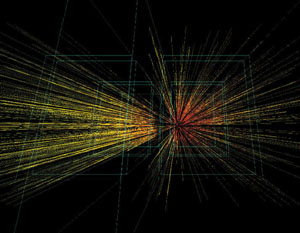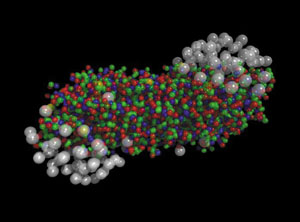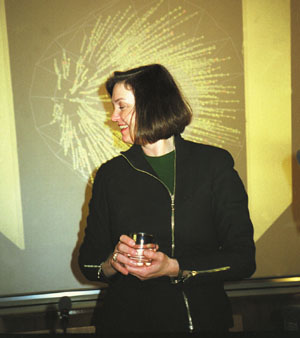After a decade of running, the results from CERN’s research programme with high-energy nuclear beams provide tantalizing glimpses of mechanisms that shaped our universe.


About a microsecond after the Big Bang, the universe was a seething soup of quarks and gluons. As this soup cooled, it “froze” into protons and neutrons, supplying the raw material for the nuclei that appeared on the scene a few minutes later.
To check if this imagined scenario is correct, since 1986 experiments at CERN have been accelerating beams of nuclear particles to the highest possible energies and piling them into dense nuclear targets. Recreating what happened in the first microsecond of creation has so far taken many years of careful and painstaking work.
The goal has been to use the energy supplied by the nuclear beams to recreate tiny pockets of primordial quark gluon plasma about the size of a big nucleus and watch them behave as “Little Bangs”. Theorists using simulation tools predict that this soup/plasma should be formed at a temperature of about 170 MeV (about 1011degrees, or 100 000 times the temperature at the centre of the Sun) with an energy concentration of about 1 GeV per cubic femtometre – seven times that of ordinary nuclear matter.
The milestones of the early universe, separated by only fractions of a second, nevertheless stretched over immense energy gaps as the Big Bang temperature plummeted. The Little Bang experiments too have to contend with vast swings of temperature/energy.
The experiments take snapshots of the particle patterns emerging from these Little Bangs, but these patterns, although embedded in the particle behaviour, are quickly masked by the surrounding nuclear debris. The challenge is to peer through this debris to glimpse the signature of the Little Bangs.
Ion beam experiments

The ion beams at CERN serve several large experiments, codenamed NA44, NA45, NA49, NA50, NA52, WA97/NA57 and WA98. Some of these studies use existing multipurpose detectors to investigate the fruit of the heavy-ion collisions. Others are special dedicated experiments to detect rare signatures.
On both the machine and the physics sides, the programme is an excellent example of collaboration in physics research. Scientists from institutes in more than 20 countries, including Italy, Japan, Germany, France, Portugal, Russia, Finland, India, Poland, Greece, Switzerland, the UK and the US, have participated in the experiments. The programme has also allowed a new productive partnership to develop between high-energy physicists and nuclear physicists, and it has considerably extended the number of scientists using CERN as a research base, with new research centres, some of them from far afield, joining the CERN research programme.
Estimates of the energy density established when the colliding nuclei coalesce point to several giga-electron-volts per cubic femtometre, suggesting that the theoretically expected critical energy threshold has been crossed.
One important quark signature is the J/psi particle, which is made of a charm quark and its antiquark. J/psis are rare because charm quarks are heavy. However, theorists suspected that the production of J/psis would be suppressed by the screening of the quark “colour” charge by the surrounding quark-gluon matter. A strong reduction in the number of J/psis leaving the fireball would suggest that hot quark-gluon plasma was initially present. This is exactly what the NA50 experiment saw.
Other particles – phi, rho and omega mesons – are composed of lighter quarks and antiquarks bound together. These mesons can be seen through the surrounding fog of dense matter via their decay into pairs of weakly interacting particles – for example, electron-positron pairs – which pierce through the surrounding strongly interacting material. In a quark-gluon plasma, the quarks and antiquarks find it difficult to lock onto each other and therefore their signals get smeared out, as seen in the NA45 experiment.
Another encouraging sign seen quite early in CERN’s heavy-ion experiments was the increased production of particles containing strange quarks. The ion projectiles only contain up and down quarks – no strange quarks. High-energy proton-proton or electron-positron collisions provide enough energy to synthesize strange quark antiquark pairs, but for the nucleus-nucleus collisions the fraction seen by the WA97 experiment was markedly higher. The greater the strangeness content of the emerging particles, the more their production levels were increased. For example, the yield of Omega baryons containing three strange quarks was 15 times normal.
In principle the cleanest quark signals are the electromagnetic ones, and WA98 has seen some preliminary signs of an increased yield of single photons radiated by quarks.
Quark chemistry
The particles leaving the fireball retain signatures of their past, pointing back in time. In elastic scattering when particles “bounce” off each other, only their momentum changes. As the fireball expands, the energy density decreases until the hadrons no longer interact – their momenta “freeze out”. The momentum distribution of the particles leaving the fireball gives a snapshot of when this freezeout occurred, at a temperature of about 100 MeV.
What happened if the fireball was much hotter and denser, when quark chemistry was operating? Once the resulting subnuclear particles emerged, their composition reflected what happened when the quarks froze. These particle distributions serve to reveal the chemical freeze-out temperature when quarks became subnuclear particles – around 180 MeV, which agrees with the critical temperature predicted by theory.
Another experimental technique, based on interferometry, is a development of the pioneering astronomical work of Hanbury, Brown and Twiss and adapted for particle physics by Giuseppe Cocconi at CERN in 1974. Looking at correlated pairs of particles, this technique measures sizes. The rate of expansion of the system is known, so size information can be extrapolated backwards to reveal the original energy density and to disentangle thermal motion from collective flow.
Heavy ions at CERN

The CERN results obtained with lead beams are the culmination of a long programme. A proposal in 1982 from heavy-ion enthusiasts suggested that the CERN machines could be used to accelerate beams of oxygen ions to extend interesting heavy-ion results obtained earlier at Darmstadt’s Unilac and Berkeley’s Bevalac.
Despite CERN’s crowded programme (the SPS proton-antiproton collider was then in full swing) and commitments to new projects such as LEP, development work for heavy-ion beams began at CERN through a Berkeley/CERN/Darmstadt collaboration. An important element was CERN’s Linac 1 injector, which had already learned how to handle deuterons and alpha particles. This was fitted with an electron cyclotron resonance ion source from Grenoble and a radiofrequency quadrupole from Berkeley.
In the mid-1980s, at the same time as CERN’s big machines were learning how to handle electrons and positrons in preparation for LEP, an experimental programme got under way at CERN’s SPS synchrotron using 200 GeV/nucleon oxygen ions. Complementary data came from a programme at Brookhaven’s AGS synchrotron with beams of 14.6 GeV/nucleon.
CERN soon extended the range of its experimental programme by supplying sulphur beams at 200 GeV/nucleon. From 1993, equipped with the new Linac 3 injector and its ion source, and in a collaboration between CERN and institutes in the Czech Republic, France, India, Italy, Germany, Sweden and Switzerland, the reach of the experiments was considerably extended using the much heavier lead projectiles.
The future
These results, announced on 10 February at CERN, resulted in a blaze of media hype. However, they are not definitive and have to be followed up. While all of the pieces of the puzzle seem to fit a quark-gluon plasma explanation, it is essential to study further this new form of matter to characterize its properties fully and confirm the quark-gluon plasma interpretation. Where exactly is the energy threshold for the new state of matter? What are the critical sizes of the produced fireballs? What is the actual transition? In a succinct analogy from theorist Maurice Jacob, “We have seen boiling water but we do not yet know what steam looks like, nor how the boiling goes.”
Although the ion beam experiments at CERN continue, the focus of heavy-ion research now shifts to the Relativistic Heavy Ion Collider at Brookhaven, which starts experiments this year. Due to start in 2005, CERN’s Large Hadron Collider experimental programme will include a dedicated heavy-ion experiment, ALICE.







